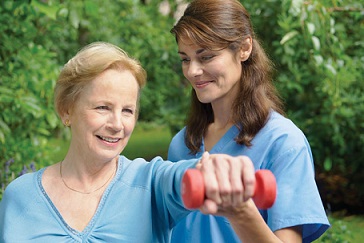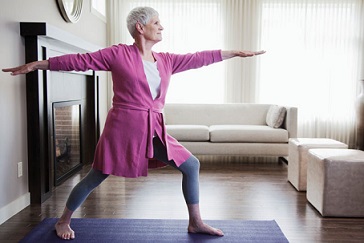As we get older, our activity levels can change, as does our range of motion. Older adults are encouraged to exercise, but what does that look like for someone who may be in a wheelchair, rely on a cane, or suffer from arthritis pain and stiff joints? While running a marathon may no longer be possible – though for some it might – it’s important to remember staying active is within everyone’s reach. Regardless of age or mobility, staying active can help improve emotional well-being and overall physical health, as well as reduce the risk for falls or other serious injuries. Use our suggestions below to encourage older loved ones to find ways to stay active and social activities they enjoy, as well as connect with peers in the community.

Simple activities focus less on working up a sweat and more on improving or maintaining mobility. Older adults who use a wheelchair or other mobility aid can perform simple movements like these every day to keep their joints loose and reduce the pain and stiffness of arthritis or a sedentary lifestyle. These simple activities can be performed while seated:
Active exercise can help your loved one maintain better balance, reduce the risk for falls, and lose weight, which can help reduce body pain. Simply walking at a modest pace for 10 to 20 minutes, three to five times per week, can help improve blood pressure, blood sugar, mobility, and weight. In fact, losing just one pound reduces pressure on the joints by as much as four times. For example, losing five pounds of weight is the equivalent of reducing stress to your joints by 20 pounds. Senior centers and gyms often provide fitness classes and programs for older adults. These activities are designed for a range of activity levels and likely offer modifications if a person has low flexibility or trouble with balance. Group activities are great for people of all ages and for seniors in particular. Exercising with a friend or a group makes us more inclined to keep attending, and the social interaction is an additional boost to emotional well-being. From chair aerobics to more active stretching activities such as yoga or tai chi, there are many activities to choose from. To stay active at home, we recommend checking out the vast resources online. There are many free senior fitness regimens and videos online, as well as healthy living communities on social media.
3 categories of activity older adults can enjoy
When home care clients ask me about staying active, some are nervous. They ask, “Won’t I get hurt if I exercise? How can I exercise if I’m in a wheelchair?” There are many levels of activity that range from social interaction all the way up to walking or jogging regularly. We think of them in three categories: simple activities, active exercise, and social activity.Simple activities

Simple activities focus less on working up a sweat and more on improving or maintaining mobility. Older adults who use a wheelchair or other mobility aid can perform simple movements like these every day to keep their joints loose and reduce the pain and stiffness of arthritis or a sedentary lifestyle. These simple activities can be performed while seated:
- Squeezing a Nerf ball with the hands or between the knees
- Tossing a soft, light ball with a child or caregiver
- Stirring a pot or mixing bowl
- Curling light weights or soup cans
- Rotating and flexing the joints: shoulders, elbows, wrists, hips, knees, and ankles
- Walking the feet away from the chair and back again several times
- Marching in place with the feet
Active exercise

Active exercise can help your loved one maintain better balance, reduce the risk for falls, and lose weight, which can help reduce body pain. Simply walking at a modest pace for 10 to 20 minutes, three to five times per week, can help improve blood pressure, blood sugar, mobility, and weight. In fact, losing just one pound reduces pressure on the joints by as much as four times. For example, losing five pounds of weight is the equivalent of reducing stress to your joints by 20 pounds. Senior centers and gyms often provide fitness classes and programs for older adults. These activities are designed for a range of activity levels and likely offer modifications if a person has low flexibility or trouble with balance. Group activities are great for people of all ages and for seniors in particular. Exercising with a friend or a group makes us more inclined to keep attending, and the social interaction is an additional boost to emotional well-being. From chair aerobics to more active stretching activities such as yoga or tai chi, there are many activities to choose from. To stay active at home, we recommend checking out the vast resources online. There are many free senior fitness regimens and videos online, as well as healthy living communities on social media.
Social activity
Mobility or pain issues can make socializing difficult. But enjoying time with friends, family, neighbors, and people in the community is worth the effort. Regular interaction with others outside the home can help your loved one feel less isolated and can increase mood, self-esteem, and emotional well-being. The physical effort it takes to get out of the house is beneficial, too. All movement, even light movement, is beneficial:- Go outdoors to enjoy the scenery and take deep breaths
- Participate in activities at the senior center
- Schedule a regular coffee or tea date with friends or neighbors
- Attend a worship service
- See a play or attend a grandchild’s school performance
